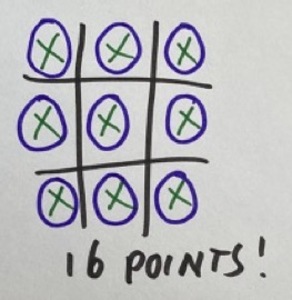This is not Tic Tac Toe

A game to work with assumptions and to reflect on how things are being handled in the organisation. How do we learn from each other?
Goal
Dig for (limiting) assumptions in the organisation
Reflect on team building
Materials
Instructions
! Do not say Tic Tac Toe
Round zero
Draw 4 Tic Tac Toe diagrams # on the flip chart and say: ”We will play a game that some of you might already know for which I need a volunteer.”
Let the volunteer choose: X / O choose the other
Play Tic Tac Toe 4 times with a volunteer, do not speak about rules and do not name the game yourself.
Count the total of points you scored together (so if you scored 1 point and the volunteer scored 2 point the total is 3 points). Some people will notice this peculiarity as the game they think they recognise is about winning from your opponent.
Make a flip chart with the rules of the game and confirm for each rule that you and the volunteer also followed this rule:
1) Per pair of two people 4x #
2) Choose each: X or O
3) XXX or OOO = 1 point (horizontal / diagonal / vertical)
Round one
Announce: “We will play this game in three rounds so we have time to get better at it. Please form pairs of two.”
Form pairs
Announce: “Maximise the score within the team! You have one minute to play the game with the four # diagrams”
Do not answer questions! If necessary, repeat: these are the rules.
When you have an odd number of participants: tell the volunteer that they ill have another rule and you will give them other instructions. When the pairs have started you tell the volunteer: "These are the only rules" and instruct him/her to walk around and observe what the other participants are doing. They are not to say anything or answer any questions.
Make an inventory of the scores and compliment the pairs. Most will have a few points but sometimes they will have more points in one pair, the most I have seen in round one is 32 valid points for one pair.
Round two
Announce: “Maximise the score within the team! You have one minute to play the game with the four # diagrams. As this is round two you get an additional task: make sure to at least double the score from round one in your team.”
Make an inventory of the scores and compliment the pairs. Some will have doubled their score, sometimes they score lower in round two. They will complain that the task is impossible (especially people who had 32 points in round one).
Round three
Same as round two but again double your score from round two
Debrief and transfer
Note for trainer: count all the cleverness that has been worked out, for example:
- Both participants choose X --> 8 points per #
- Multiple X or O in one box
- Pairs join together to enlarge the team (2 pairs means 8 diagrams #)
- Linking all 4 # together #### allowing you to keep counting
- - ...
With a volunteer in front of the group: what did you notice about what people were doing / saying?
What (hidden) rules did you think up yourself?
What made you start playing Tic Tac Toe?
What happened when you found out that others had ‘broken’ the hidden rules?
Make the transfer to their workplace: What assumptions are in your day to day work, how do you make your own work more complicated then necessary, did you learn from others who scored better than you, did you share your insights about the opportunities you saw, …? Anything that happened can be a trigger for dialogue
Translated with help from www.DeepL.com/Translator (free version)
Attachments
- Two pairs join.jpeg
- Lets combine.jpeg
- 16 points.jpeg
- 8 Points.jpeg
Background
Many years ago I was in a workshop where someone used a similar exercise and I built on that.